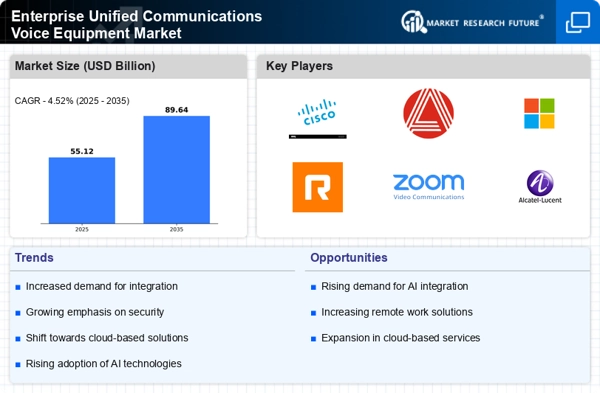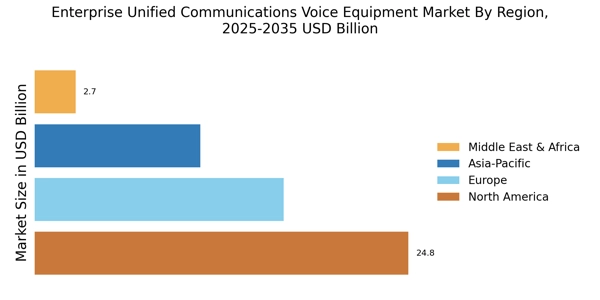The Enterprise Unified Communications Voice Equipment Market is currently characterized by a dynamic competitive landscape, driven by rapid technological advancements and an increasing demand for integrated communication solutions. Major players such as Cisco Systems (US), Avaya (US), and Microsoft (US) are at the forefront, each adopting distinct strategies to enhance their market positioning. Cisco Systems (US) emphasizes innovation through continuous investment in cloud-based solutions, while Avaya (US) focuses on expanding its portfolio through strategic partnerships and acquisitions. Microsoft (US), leveraging its extensive ecosystem, integrates voice solutions with its existing software offerings, thereby enhancing user experience and operational efficiency. Collectively, these strategies contribute to a competitive environment that is increasingly focused on technological integration and customer-centric solutions.
In terms of business tactics, companies are increasingly localizing manufacturing and optimizing supply chains to enhance responsiveness to market demands. The market structure appears moderately fragmented, with several key players exerting influence while also facing competition from emerging firms. This fragmentation allows for diverse offerings, yet the collective strength of established companies shapes the overall market dynamics, fostering innovation and competitive pricing.
In August 2025, Cisco Systems (US) announced the launch of its new AI-driven communication platform, which aims to streamline enterprise communication by integrating voice, video, and messaging into a single interface. This strategic move is significant as it positions Cisco to capitalize on the growing trend of AI integration in communication technologies, potentially enhancing user engagement and operational efficiency.
In September 2025, Avaya (US) completed its acquisition of a leading cloud-based communication provider, which is expected to bolster its capabilities in delivering scalable solutions to enterprises. This acquisition reflects Avaya's commitment to expanding its cloud offerings and indicates a strategic shift towards enhancing its competitive edge in the rapidly evolving market.
In July 2025, Microsoft (US) unveiled a new feature within its Teams platform that integrates advanced voice recognition capabilities, allowing for more efficient meeting transcriptions and enhanced accessibility. This development underscores Microsoft's focus on innovation and user experience, potentially attracting a broader customer base seeking advanced communication tools.
As of October 2025, the competitive trends in the Enterprise Unified Communications Voice Equipment Market are increasingly defined by digitalization, sustainability, and the integration of artificial intelligence. Strategic alliances among key players are shaping the landscape, fostering innovation and collaborative solutions. Looking ahead, competitive differentiation is likely to evolve from traditional price-based competition towards a focus on technological innovation, reliability in supply chains, and the ability to deliver comprehensive, integrated solutions that meet the diverse needs of enterprises.


















Leave a Comment